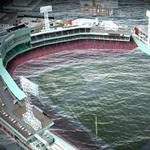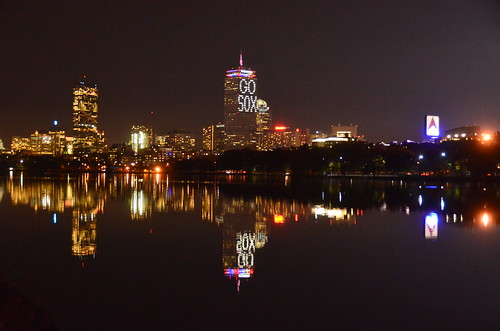波士頓紅襪隊日前在擁有101年歷史的芬威球場(Fenway)拿下1918年來的首次世界大賽冠軍。但是美國國家野生動物保護聯盟警告,芬威球場受氣候變遷影響,淹水的風險逐漸升高。
地勢低窪的芬威球場因坐落在馬迪河旁的鹹水沼澤地(the fen)而得名。國家野生動物保護聯盟(National Wildlife Federation,NWF)的Miles Grant在部落格上指出,不僅是芬威球場的四周,波士頓市中心有大部分都位於填平的沼澤地上。
因為比賽場地和場外街道等高的關係,芬威球場的排水效果不佳,2010年才被暴雨淹沒了防空洞和擊球籠。只要馬迪河的河水溢出河床,紅襪球迷最常經過的地鐵站──肯莫爾廣場站就會淹水。
芬威球場和紅襪棒球俱樂部已在想辦法對抗氣候變遷。環團也試圖在11月5日市長選舉前提醒波士頓民眾,暴雨和氣候變遷使海平面上升,洪水也將更加頻繁。
 2008年,紅襪隊成為大聯盟史上第一個在棒球場加裝太陽能板的球隊。這些太陽能板供應球場熱水,每年約省下18噸的二氧化碳排放。紅襪隊管理團隊表示,這大約等同於種下4.86英畝面積的樹,或是少開43,611英哩的車。
2008年,紅襪隊成為大聯盟史上第一個在棒球場加裝太陽能板的球隊。這些太陽能板供應球場熱水,每年約省下18噸的二氧化碳排放。紅襪隊管理團隊表示,這大約等同於種下4.86英畝面積的樹,或是少開43,611英哩的車。
在芬威球場,部分節能LED燈顯示看板的用電量僅佔傳統看板的1/10,其他環保措施還包括省水廁所、太陽能垃圾壓實機、資源回收以及使用回收紙包裝食物。紅襪隊的地勤人員開的是零廢氣、零噪音和零污染的電動工具車,用以生質柴油為燃料的割草機,也漸漸轉為使用有機肥料和生物促生劑(bio-stimulants)來培養草地。
「這些措施都是為了因應氣候變遷和保護環境而盡一份心力,亦是球隊的驕傲。紅襪球團和我們的合作夥伴──美國自然資源保護委員會(the Natural Resources Defense Council,NRDC)的努力獲得環保署的肯定,並於2008年獲頒環境貢獻獎。」紅襪隊的網站上寫道。
Boston’s 101-year-old Fenway Park – where the World Series was won by the Boston Red Sox tonight for the first time since 1918 – is at increased risk of flooding due to climate change, warns the National Wildlife Federation.
The environmental group points out that low-lying Fenway Park took its name from The Fens, the saltwater marshland around the Muddy River on which it was built.
Parts of the neighborhood, like much of downtown Boston, were built on filled-in marshy areas, blogs the NWF’s Miles Grant.
As recently as 2010, heavy rains flooded the dugouts and batting cages at Fenway. The water doesn’t drain well because the playing field is at street level.
The subway station most Fenway fans use, Kenmore Square, suffers major flooding when the Muddy River has overflowed its banks.
The environmental group wants to remind Bostonians before the upcoming mayoral election on November 5, that climate change is making flooding more likely due to “heavier rainfalls and climate change-fueled sea level rise.”
Fenway Park itself and the Red Sox ball club are doing what they can to fend off climate change.
In 2008, the Red Sox became the first team in Major League Baseball to install solar thermal panels at a ballpark. The panels help heat water throughout the facility, saving an estimated 18 tons of carbon dioxide emissions each year. The Red Sox management says that’s the environmental equivalent of planting 4.86 acres of trees, or not driving a car for 43,611 miles.
The energy-efficient LED lighting systems for some large billboards at Fenway Park use one-tenth the power of equivalent, traditional lighting displays.
Environmentally-friendly measures taken at Fenway Park include upgraded restrooms that reduce water use, solar powered trash compactors, recycling waste and using recycled materials for food service paper goods.
The team’s grounds crew uses biodiesel fuel in all mowers and uses electric utility carts that are exhaust and noise pollution free. They are also using more organic fertilizers and bio-stimulants on the grass.
“Taken together, these measures are making a real difference in addressing climate change and protecting our environment,” the Red Sox said in a statement on their website. “They are points of pride for the team, and we were honored when the EPA recognized our commitment by awarding the Environmental Merit Award for excellence to the Red Sox and our partner in this effort, the NRDC [Natural Resources Defense Council] in 2008.”
※ 全文及圖片詳見:ENS








